#Michał Stachowicz
Explore tagged Tumblr posts
Text

Alexander I Crowned King of Poland
Artist: Michał Stachowicz (Polish, 1768–1825)
Date: 1815-1825
Medium: Oil on canvas
Collection: National Museum in Kraków, Poland
Alexander I of Russia
Alexander I (23 December [O.S. 12 December] 1777 – 1 December 1825), nicknamed "the Blessed", was Emperor of Russia from 1801, the first king of Congress Poland from 1815, and the grand duke of Finland from 1809 to his death in 1825. He ruled Russia during the chaotic period of the Napoleonic Wars.
#historical art#painting#oil on canvas#narrative art#oil painting#fine art#artwork#russian history#historical scene#landscape#coronation of alexander i of russia#russian empire#russian monarchy#alexander i of russia#coronation ceremony#male figures#female figures#costume#polish culture#polish art#michał stachowicz#polish painter#european art#19th century painting#national museum in krakov
18 notes
·
View notes
Text
The Galician campaign of 1809
Today let me tell you a little bit about the Galician campaign of the Austro-Polish war of 1809, which proved to be a great success for the Duchy of Warsaw.
After the battle of Raszyn there happened the series of small battles, which prevented Austrians from crossing the Vistula, thus leaving the initiative on the right bank of the river firmly with the Poles. So, the Polish forces under Poniatowski’s command moved along Vistula to the South-East, to the lands Austria seized during the latest partition of Poland.
On the 14th of May the Polish Army entered Lublin:
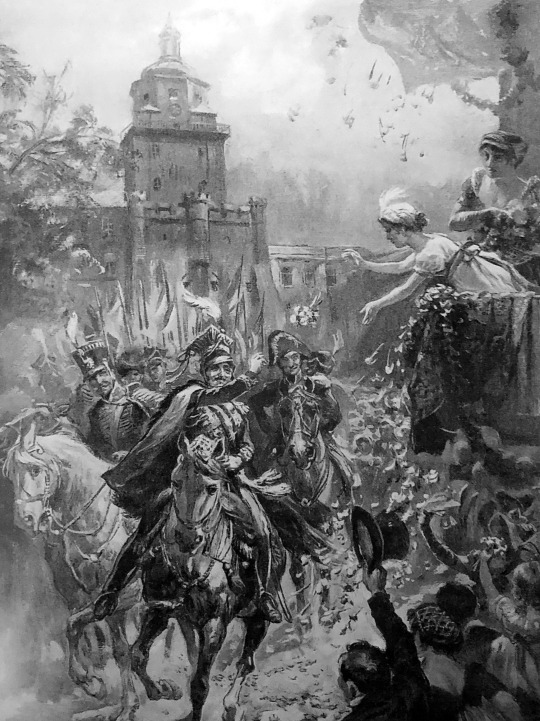
Konstanty Gorski, "Prince Józef Poniatowski enters conquered Lublin in 1809, showered with flowers by ladies"
As Kajetan Koźmian recalls in his memoirs, Poniatowski and his men were greeted with "joy and elation", and in the evening "... the city and the citizens gave a great ball <...> in the house in Korce. Prince Józef honored them with his presence starting the ball."
The next city on the way of the Polish Army was Sandomierz, and after a short siege it was taken on the 18th of May.

Siege of Sandomierz in 1809.
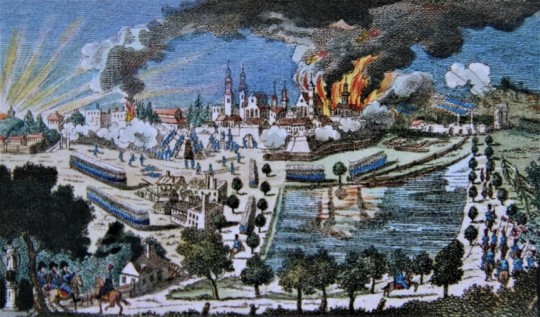
Michał Stachowicz, a scene from the battles in Galicia ("The Capture of Zamość")
Then there was Zamość, where the Polish trooped entered on the 20th of May.
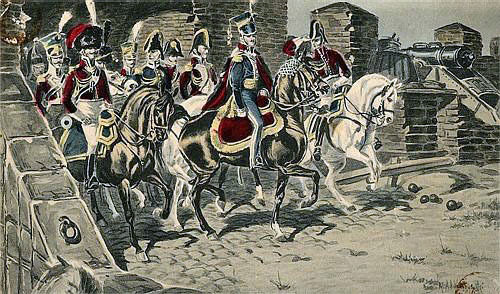
Siege of 1809, M. Adamczewski Entry of Prince Poniatowski to Zamość (postcard)
On the 27th of May the Polish advanced forces even reached the city of Lwów, but prince Józef wasn’t among them.
Meanwhile the Austrians under command Archduke Ferdinand realized the precariousness of their position in the center of Poland, and on the 1st of June left Warsaw for the south.
Poniatowski, for his part, decided not to engage with the Austrian, focusing instead on "liberating” as much Galician land as possible.
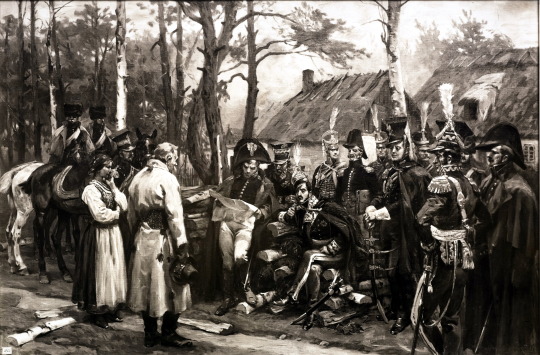
Prince Józef Poniatowski seeks information from local peasants in Galicia in 1809, a photo of Stanisław Bagieński's painting
On the 3rd June there appeared the third participant of the events - Russian forces crossed the Austrian border to Galicia as well. And though formally they were acting as Napoleon’s ally, as was prescribed in the Tilsit Treaty, their real goal was to prevent the Poles from taking too much of the Austrian-held territories.
So, to outwit the Russians prince Józef was taking Galician cities not in the name of the Duchy of Warsaw, but in the one of emperor of the Frenchmen. Like the proclamations were being made in the name of Napoleon, the eagles on the coats-of-arms replacing the Austrian ones were not Polish and French etc.
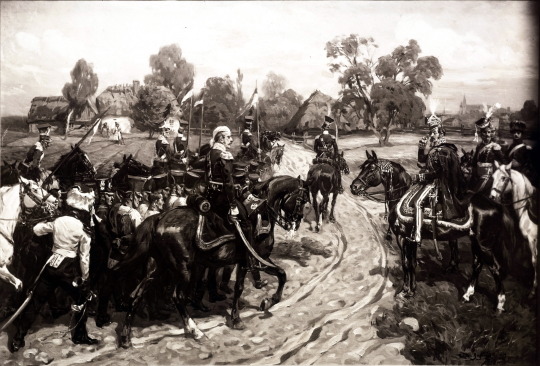
Lancers lead Austrian prisoners of war near Kraków in 1809, in front of Prince Józef Poniatowski, a photo of Stanisław Bagieński's painting
Then, in the outer theater of war on the 6th of July the French defeated the Austrians at the Battle of Wagram. And according Franco-Austrian truce signed five days later the land division was to take place along the line where the troops were at the time of receiving news of the truce, not at the time its signing.

The Austrian army leaves Wawel, a postcard based on the painting of Wojciech Kossak
And so began the race between Russians and Poles, to advance to as farther as possible.
In the middle of July both armies reached Kraków.

PRINCE JOSEPH'S ENTRY TO KRAKOW. A drawing by Jan Feliks Piwarski.
And there the clash of the interest took place.
Poniatowski approached the city from the side of St. Florian's Gate, but it turned out that the Austrians, wanting more comfortable terms of capitulation, had already let Russian troops into Kraków.
The Russians, namely the Cossacks of General Sievers, wanted to deny Poniatowski passage. But Prince Józef, as Dezydery Chłapowski recalls in his memoirs, "draw his broadsword and with together his staff galloped into the gate through the Cossacks". The Polish infantry followed its commander "in a double step <...> so that the Cossacks were pressed against the walls of the gate." Seeing this, Mariampol's hussar regiment, which was stationed at that time in the market square, make a decision to put up resistance and due to this, the whole Polish army was able to enter the city.

Michał Stachowicz, The entry of Prince Józef Poniatowski into Krakow on July 15, 1809
Then, as Ambroży Grabowski recalled, when prince Józef’s troops reached the market square, “in front of the church of St. Wojciech, the magistrate went out to meet the prince, to give him the keys of the city”.
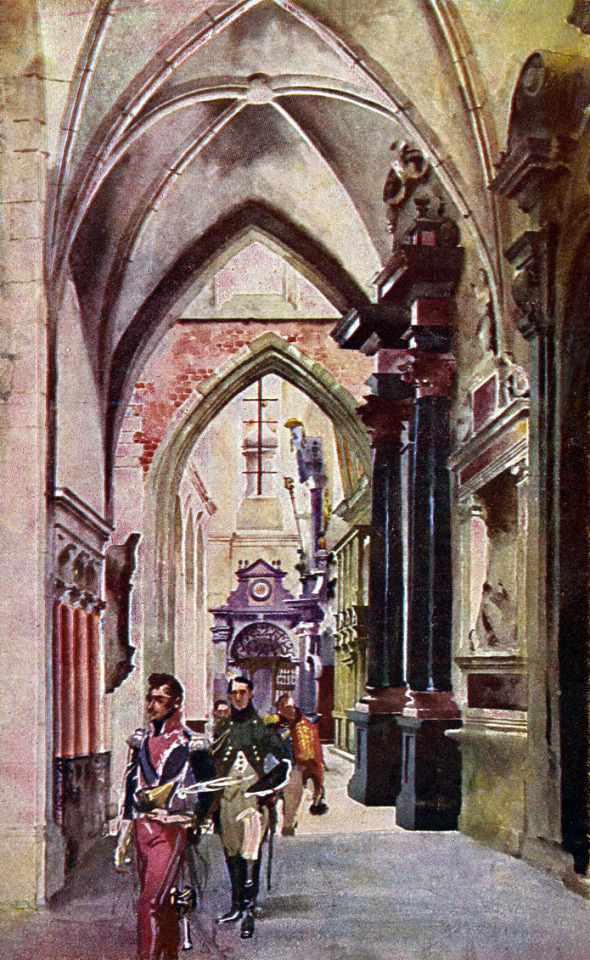
Józef Poniatowski in the Cathedral after Kraków was taken from the Austrians, an image by Stanisław Tondos and Wojciech Kossak
Most probably prince Józef visited the Wawel cathedral during his sojourn in Kraków that time. (In a small voice: little did he know that in 8 years he’ll be buried there...)
And after exactly a month since the Polish troops entered Kraków, there was a ball arranged in the Cloth-hall, the image depicting it I have already posted here.
#Poniatowski#Jozef Poniatowski#józef poniatowski#1809#Galicia#Lublin#Sandomierz#Zamość#Kraków#Austro-Polish War#Konstanty Gorski#Michał Stachowicz#Stanisław Bagieński#Wojciech Kossak#Feliks Piwarski#Kajetan Koźmian#Dezydery Chłapowski#ambroży grabowski
34 notes
·
View notes
Text

Michał Stachowicz (14 August 1768, in Kraków – 26 March 1825, in Kraków) was a Polish painter and graphic artist in the Romantic style.
His father was a printer, bookbinder and bookseller. In 1782, he was enrolled in classes at the Painter's Guild, where he studied with Franciszek Ignacy Molitor, a Czech painter working at the Royal Court, and Kazimierz Mołodziński (?–1795), a religious painter. In 1787, he became a Master in the guild. From 1817 until his death, he was a teacher at Saint Barbara's gymnasium and, for many years, was a member of the Kraków Scientific Society
In 1816, he received a major commission from Bishop Jan Paweł Woronicz [pl] to do wall paintings at the Bishop's Palace, which took two years to complete. Only thirty-two years later, they were destroyed by a fire. In 1820, he was given another major commission from the architect, Sebastian Sierakowski, to paint a mural at the Collegium Maius depicting the history of the Jagiellonian University
His best known works depicted contemporary historical events, many of which he witnessed, such as "Kościuszko's Oath on the Market Square" and "The Entrance of Prince Józef Poniatowski into Kraków". He also did genre scenes, portraits, and religious paintings; notably the Stations of the Cross at the Church of St. Casimir the Prince and images for two side altars at the church in Jangrot. He also worked as a lithographer and illustrated the Monumenta regum Poloniae Cracoviensia (Tombs of the Kings of Poland in Kraków)
-wiki
0 notes
Video
vimeo
POLPHARMA - Starazolin from Platige Image on Vimeo.
Yet again our VirtualSet made an appearance on TV! Take a look at the second commercial that we created with LemonFilm. If you cannot tell if it’s shot in the real pharmacy or the studio then we achieved our goal!
Client: Polpharma
Agency: Cut The Mustard
Director: Armin Kurasz
II Director: Michal Guga
DOP: Tomasz Ziółkowski
Production: Mariusz Kępka, Dorota Piekuś, Kinga Piwowarska
Scenography: Gwidon Busilo
Costiumes: Ania Fechner
MUA: Kamila Jodko Make up Artist
Postproduction: ICE Images / VR Set Platige Image
Platige Broadcast team:
Michał Lewicki
Piotr Kierzkowski
Marcin Placek
Arif Nugroho
Piotr Gęsek
Anna Pokora-Grabkowska
Marek Jankowski
Agnieszka Stachowicz
Maja Boruszewska
Paweł Kalinowski
0 notes
Photo










Michał Stachowicz (1768-1825), Polish painter and litographer of the Romanticism era. Specialized in historical and genre scenes, he depicted many important events of the late 18th century / early 19th century, the early phases of the Partitions of Poland, being a valuable reference to the clothing and equipment of that era. Pictures via Wikimedia.
#Michał Stachowicz#art#Polish art#history#historical clothing#18th century#19th century#Kościuszko Uprising#Tadeusz Kościuszko#Kosynierzy#places in the past#uprising
11 notes
·
View notes
Text

Michał Stachowicz. Bandura Player with a Jew
1 note
·
View note
Text

Alexander I Crowned as King of Poland
Artist: Michał Stachowicz (Polish, 1768–1825)
Date: 1815-1825
Medium: Oil on paper glued to canvas
Collection: National Museum in Kraków, Poland
Alexander I
Alexander Jagiellon (Polish: Aleksander Jagiellończyk; Lithuanian: Aleksandras Jogailaitis; 5 August 1461 – 19 August 1506) was Grand Duke of Lithuania from 1492 and King of Poland from 1501 until his death in 1506. He was the fourth son of Casimir IV and a member of the Jagiellonian dynasty. Alexander was elected grand duke of Lithuania upon the death of his father and became king of Poland upon the death of his elder brother John I Albert.
#panting#mihal stachowicz#polish painter#polish history#men#women#landscape#coronation#polish art#polish royalty#european art#19th century painting#oil painting#artwork#fine art#polish culture#narrative art
2 notes
·
View notes